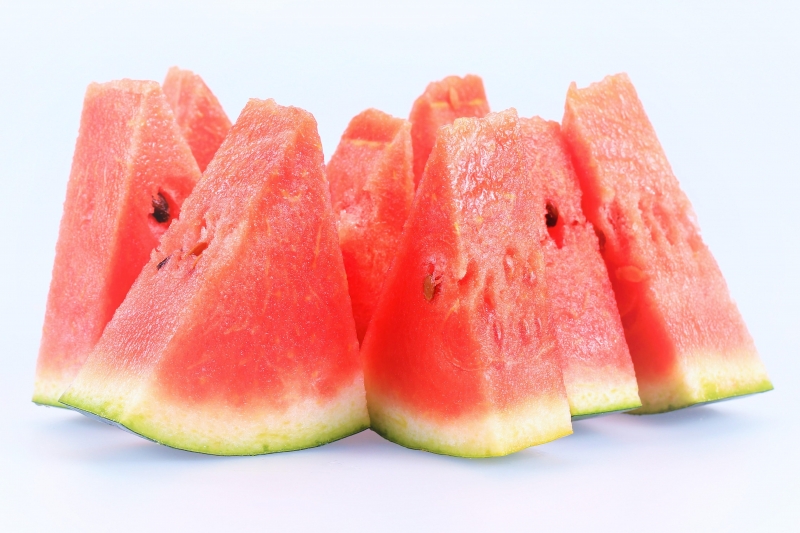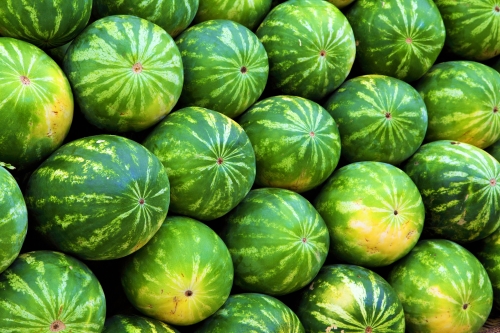
The watermelon (Citrullus lanatus) is related to cucumbers, pumpkins and squash. About 200 to 300 varieties are grown in the United States and Mexico, but only about 50 varieties are very popular. All parts of a watermelon can be eaten, even the rind. Guinness World Records says the worlds heaviest watermelon was grown by Lloyd Bright of Arkadelphia, Arkansas, in 2005. It weighed 268.8 lbs. (121.93 kg)!
Watermelon and health benefits
Watermelons are an excellent source of several vitamins: vitamin A, which helps maintain eye health and is an antioxidant; vitamin C, which helps strengthen immunity, heal wounds, prevent cell damage, promote healthy teeth and gums; and vitamin B6, which helps brain function and helps convert protein to energy. Watermelon, however, has the highest concentrations of lycopene of any fresh fruit or vegetable. Though the tomato (Solanum lycopersicum) is more well-known as a source for lycopene (and in fact, its name is derived from lycopersicum), lycopene is a carotenoid found in many red foods, including watermelon, papaya, pink grapefruit, and red carrots.
Watermelon and folk medicine
Ancient Egyptians used watermelon to treat reproductive problems such as erectile dysfunction and prostate inflammation. In Traditional Chinese Medicine, watermelon is considered cooling and moistening, producing a diuretic effect, and commonly is used to treat thirst, edema, and inflammation of the kidney and urinary tracts. The peoples of Russia and Central Asia used watermelon as a diuretic and to cleanse the blood.
 |
Watermelon and dietary
Because watermelon is 92% water, many traditional uses of watermelon overlap with current uses, including hydration, cleansing, and eliminating impurities. Since watermelon is digested relatively quickly, the folk traditions of the Papua New Guinea aborigines known as Onabasulu advised against eating watermelon and other juicy fruits after a heavy meal or if suffering from a stomachache. Nutrient profile of watermelon is about 150 gram means 46 calories. |
Watermelon and presence
The watermelon probably originated in the Kalahari Desert in Africa. Egyptians placed watermelons in the burial tombs of kings to nourish them in the afterlife. The first recorded watermelon harvest is depicted in Egyptian hieroglyphics from about 5,000 years ago. Merchants spread the use of watermelons along the Mediterranean Sea. By the 10th century, watermelons had found their way to China, which is now the worlds top producer of watermelons. The Moors in the 13th century brought watermelons to Europe. The watermelon likely made its way to the United States with African slaves. Early explorers used watermelons as canteens. Each fruit forms from a yellow flower, and the spherical or ovoid fruit is typically smooth and green, or green with lighter banded stripes. Currently, watermelons are cultivated all over the world, with Asia producing 60% of watermelons globally.
Watermelon and allergy, safety concerns
If you have certain allergies, however, you may be susceptible to developing a watermelon allergy. Watermelon allergy is often associated with ragweed pollen. If you have an allergy to watermelon, eating the fruit can cause your throat and mouth to swell and itch. Your tongue may also swell in response to the allergen.
 |
Watermelon and foods
The first cookbook published in the United States in 1776 contained a recipe for watermelon rind pickles. African cuisine treats the watermelon as a vegetable and uses the entire fruit: seeds, rinds, and flesh. The seeds are eaten as snacks, added to dishes, or ground into flour for use in baked goods. The rind can be stir-fried, stewed, candied, pickled, or grilled. The flesh is eaten or juiced, but it can also be fermented into alcohol; in the southern part of Russia, the juice is combined with hops to make beer. Watermelon and cosmetics Watermelon extract gives the look of a younger, regenerated skin. Has been shown to reduce appearance of skin redness after UV irradiation. |
 |
Watermelon motifs are becoming especially popular, popping up on everything from shoes to hair accessories to fingernails. This summer will be all watermelon all the time. This project is kid-friendly, inexpensive, and can easily be accomplished in under an hour (plus drying time). Follow the steps here. |
 |
Watermelon and festival There are numbers of watermelon festivals worldwide in late summer. In Australia the Chinchilla Melon Festival had over 15,000 attendees to celebrate everything melon related. Festival attendees are even treated to the completely ridiculous sport of water(melon) skiing! While many would think that this is a giant waste of delicious fruit, it is actually not too wasteful. The people donating the melons for the festival only use overripe, unsellable watermelons. |
Become part of the CK community by uploading and sharing traditional or personal recipes. Once you've logged in you can upload, save and print your dishes online.